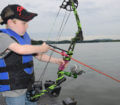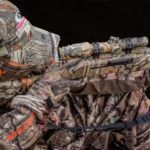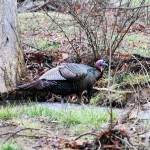Editor’s Note: Eva Shockey, well-known outdoors woman, has traveled all over the world taking big game animals with bows and rifles. But she never had hunted fish until a couple of years ago when she tried bowfishing at Lake Guntersville in north Alabama. Lake Guntersville was selected for a bowfishing tournament due to the large number of carp, gar, drum and catfish living there. During the summer months, when most hunting seasons are closed, bowfishing is a fun way to get outdoors and hunt fish.
 I’m really glad I got to attend this bowfishing tournament and learn about this new hunting sport. I met so many great people and saw unique bowfishing boats. One team that entered the bowfishing tournament on this weekend was a team named Backwater that had their entire airboat wrapped in Mossy Oak (www.mossyoak.com) camo, as well as their arrow holders and the rudders with which they guided the airboat. I enjoyed seeing the big airboat style bowfishing boats and also the smaller johnboats with shooting platforms built on the tops of them and lights all the way around their bows.
I’m really glad I got to attend this bowfishing tournament and learn about this new hunting sport. I met so many great people and saw unique bowfishing boats. One team that entered the bowfishing tournament on this weekend was a team named Backwater that had their entire airboat wrapped in Mossy Oak (www.mossyoak.com) camo, as well as their arrow holders and the rudders with which they guided the airboat. I enjoyed seeing the big airboat style bowfishing boats and also the smaller johnboats with shooting platforms built on the tops of them and lights all the way around their bows.
Although this tournament was primarily a boat tournament, I learned that many of the bowfishermen I met started off using their old hunting bows or buying inexpensive bows at pawn shops and then waded creeks, rivers and lakes to take the carp, buffalo, gar and other rough fish that they spotted in the shallow water. You can start bowfishing very inexpensively without a boat, lights or any of the other equipment that the more-serious bowfishermen use. All you really need is an inexpensive bow, a Muzzy fish arrow, a closed-face spinning reel, a pair of tennis shoe, shorts and a t-shirt. Then, you’re ready to go bowfishing.
I can’t believe what a great sport bowfishing is, and that I’ve never been. I’ll be back bowfishing next year or at least that’s my plans. If you’ve never hunted fish in the shallows during the spring, summer and early fall, particularly at night, and if you love to shoot a bow, I strongly recommend you try bowfishing. The sport is a lot of fun, and you get to shoot a lot.
 Fish Hunters Primarily BowFish for:
Fish Hunters Primarily BowFish for:
Many other species of fish are taken by bowfishermen, as evidenced by the list of the almost 50 species in the Bowfishing Association of America’s records. But here we’ve tried to give you information on some of the primary freshwater rough fish bowfishermen enjoy hunting and taking.
* Bowfins (www.bowfinanglers.com) – Known as America’s toughest sportfish for their fight for 100,000 years, bowfins date back to the Mesozoic Era, the Jurassic period. You’ll find bowfins throughout the eastern U. S. in the Mississippi River and its tributaries and in the South as far west as Texas. Visit http://roughfish.com to learn more. Other names for bowfins that have edible eggs that may be sold as caviar, include mud fish, blackfish, cypress trout, dogfish, grindle and speckled cat. They are not snakeheads, which are foreign invaders on the kill list. The world’s record bowfin from South Carolina is 21 pounds, 8 ounces, but generally these fish reach 25-28 inches in length and 2-10 pounds.
Primarily gill breathers, bowfins also have primitive lungs and can breathe air. They feed on insects, fish, amphibians, snakes, turtles and crustaceans and are voracious eaters. They prefer slower water in rivers and streams but also may be found in faster water. Bowfins also live in ponds and lake, and you’ll find them in the weeds, brush, snags and undercuts. Bowfishermen enjoy fishing for bowfins at night, since they’re nocturnal. Bowfins can survive 10-12 years in the wild.
* Buffalos – This U.S. freshwater fish is also found in Canada, Mexico and Guatemala and is the largest North American sucker. Sometimes mistaken for carp, they lack the whisker-like mouth appendages of carp. Buffalos live in most types of water where panfish are found, like ponds, creeks, rivers and lakes, and were caught by the Lewis and Clark Expedition. However, be careful of eating these fish, although there are YouTube videos available showing how to fillet them, because there’s been a link between eating these fish and developing Haff Disease that causes a muscle injury syndrome, including muscle weakness, pain, chest pain, vomiting and confusion. The symptoms eventually resolve, but sometimes patients have fatigue for months.
* Carp (www.wildcarpcompanies.com; www.americancarpsociety.com; www.carpanglersgroup.com; www.carpology.net) – Numerous types of carp exist in American waters. This oily freshwater fish is native to Europe and Asia, has a great capacity for hearing and is considered extremely smart. Carp have a set of barbels or whiskers by their mouths like a catfish does. Some carp species live in brackish water but will return to fresh water to spawn. Carp are very versatile and can live in a wide variety of habitats, including highly-degraded areas.
Carp long have been an important food to humans, but not in the U.S. Some carp, including the goldfish breeds and the Koi, are popular ornamental fishes. The USDA has listed several carp as invasive species, and worldwide, large sums of money are spent on carp control. So, many states welcome bowfishermen to take carp. Too, in Europe, even when not fished for as food, anglers love to fish for carp, which are difficult to hook. Various carp species have been domesticated and reared as food fish across Eurasia for thousands of years. Possibly the first carp aquaculture was started in ponds in China 2400 years ago.
In Poland, Crucian carp (not found in the U.S.) are considered the best-tasting fish in the country and are used in many recipes, generally with sour cream. Russians also use this carp species to prepare borscht, and the Japanese stir fry it with rice. India, Germany, the Czech Republic, the Sudan and Iraq enjoy carp dishes prepared in various ways from frying to soups, and wrapped with spices and herbs and cooked in banana leaves. Mud carp generally are consumed by the poor, due to its low cost of preparation, and also are sometimes dried and salted or canned. In China, you’ll find mud carp in markets made into fish cakes, fish balls and dumplings.
The most prominent carp include silver carp, common carp, grass carp, bighead carp, Crucian carp, Catla (Indian) carp, Mrigel carp, black carp and mud carp.
1) Bighead Carp – This fish is now established in North America and Europe.
2) Common Carp – This is the most-widespread predator of the species and may grow to 5 feet and reach a weight of 80 pounds. They’ll eat most anything and like bread and luncheon meat.
3) Grass Carp – Also known as the White Amur, the grass carp was widely introduced to Europe and the U.S. for controlling weeds. It originated in the Amur River and is native to Siberia and China. These fish can grow over 10 pounds a year.
4) Mirror Carp – Here’s another carp that will eat most anything and can grow to 5 feet and weigh 60 pounds.
5) Silver Carp – They threaten to outcompete native U.S. fish for food. Silver carp populations have exploded, and you may see dense schools of them milling about and jumping below dams on big southern rivers.
* Gar – Largely unchanged over the past 100-million years, gar are often called living fossils and are closely related to the bowfin. They’re primarily freshwater fish found today in North America, from Montana to southern Quebec to Costa Rica. Having once had a more-extensive range, gar fossils have been found in Europe, Africa, South Asia and South America.
 Also called garpikes, a name that comes from the Anglo-Saxon word for spear, gar are long and tubular with an oversized, generally elongated snout and a short and wide, shovel-shaped bill. Their skin is covered in a coat of hard, diamond-shaped scales that create protective armor. Indians once use the gar’s skin to wear as body armor and the scales as arrowheads. Early American pioneers covered the blades of their plows in gar skin. The Chickasaw and the Creek Native Americans also had ritual garfish dances.
Also called garpikes, a name that comes from the Anglo-Saxon word for spear, gar are long and tubular with an oversized, generally elongated snout and a short and wide, shovel-shaped bill. Their skin is covered in a coat of hard, diamond-shaped scales that create protective armor. Indians once use the gar’s skin to wear as body armor and the scales as arrowheads. Early American pioneers covered the blades of their plows in gar skin. The Chickasaw and the Creek Native Americans also had ritual garfish dances.
Gars have large mouths packed with sharp, pointed teeth. They eat small fish and invertebrates such as crabs. Although sluggish, gar are capable of impressive bursts of speed. They live often more than 20 years in the wild and grow to 10 feet and may weigh up to 300 pounds. Gars survive in even the most-inhospitable waters. A gar has a swim bladder that can function as lungs that it can fill by gulping air to supplement its gill breathing in low-oxygen environments. Gar prefer shallow and weedy sections of rivers, lakes and bayous, often congregating in small groups. They have been known to travel from lakes and rivers through sewers to reach ponds. Gar meat is edible – particularly in Louisiana where gar balls are popular, but the eggs are toxic. Major types of gar include:
1) Alligator Gar – This largest of the gar family has a spiral valve intestine common to the digestive systems of sharks and are among the biggest of North America’s freshwater fish. They got their name from the alligator and mainly are found in the southern U.S., although their one-time range was as far north as central Kansas, Nebraska, Ohio, Iowa and west-central Illinois.
2) Florida Gar – Found only in Florida, this gar is almost identical to the spotted gar.
3) Longnose Gar – The rear fins and the tail of the longnose gar are bunched together at the back of the fish to provide quick acceleration for ambushing prey. They can live almost anywhere, including large river systems, attached backwaters, swamps, marshes, sloughs, oxbows and lakes. They prefer still or slow-moving water with an abundance of aquatic vegetation.
4) Shortnose Gar – This gar is smaller than others, generally reaching only 5 pounds. It has a broad and flat mouth like a duck’s bill that’s still filled with sharp teeth. The shortnose is a river fish and even is found in areas with current. It also stays in the mouths of feeder creeks.
5) Spotted Gar – This short-billed gar with spots on its head and body reaches a maximum weight of 10 pounds and primarily lives in the South.
6) Tropical Gar – very similar to the shortnose gar, it’s not found in the U.S. but is found from southern Mexico through northern Costa Rica.
To learn more about bowfishing, go to John E. Phillips’ book “The Bowfishing Bible” at http://amzn.to/22zX7Zz.










